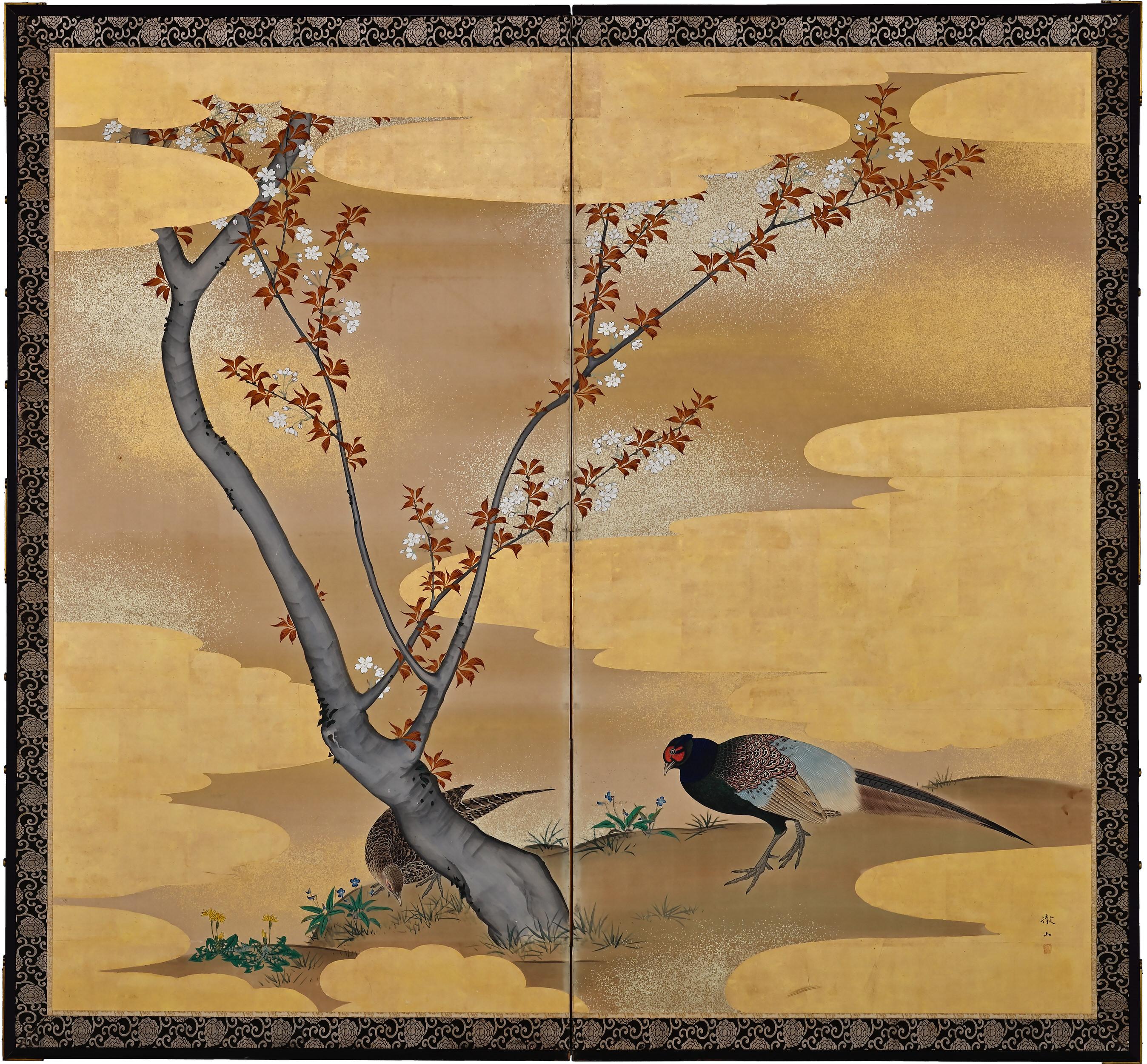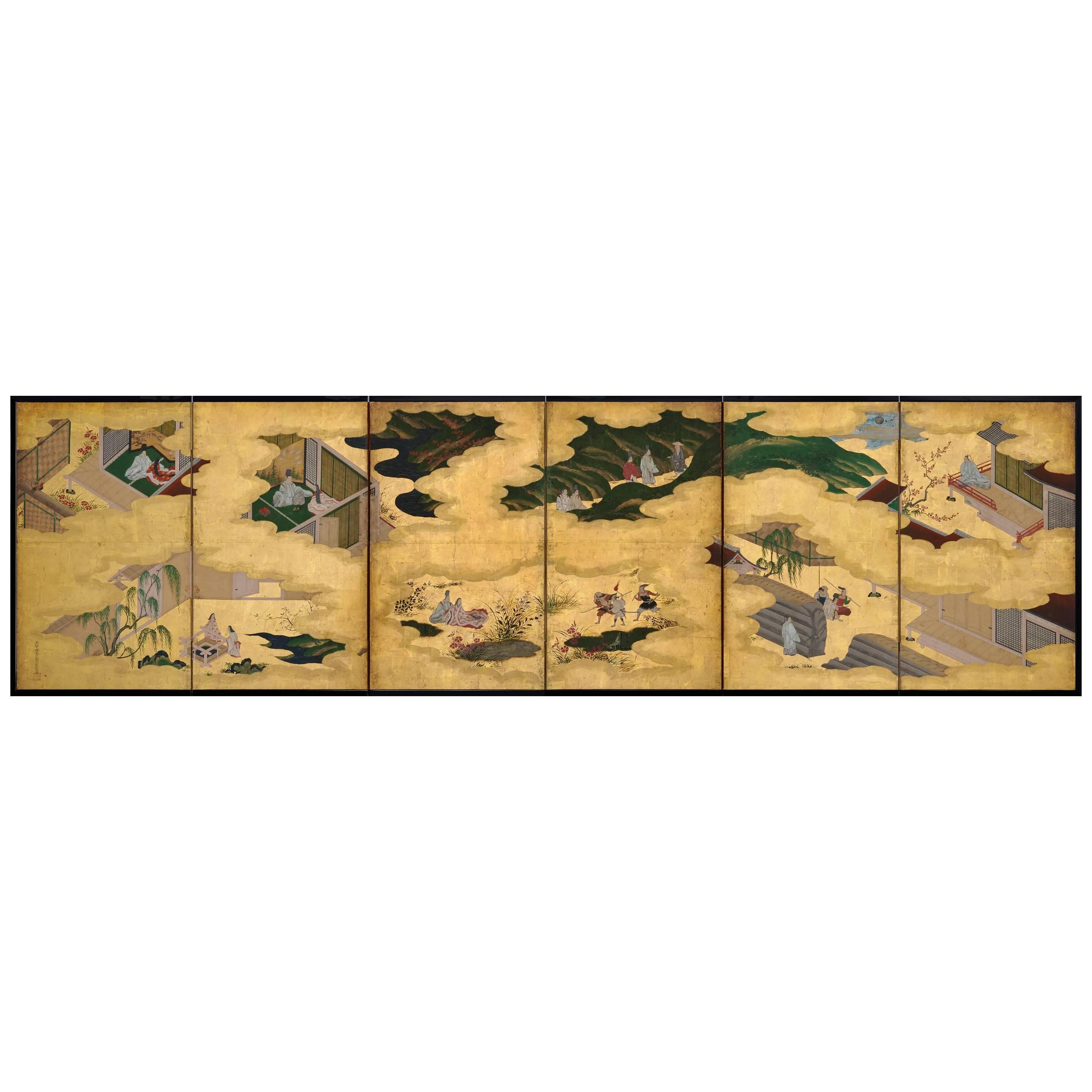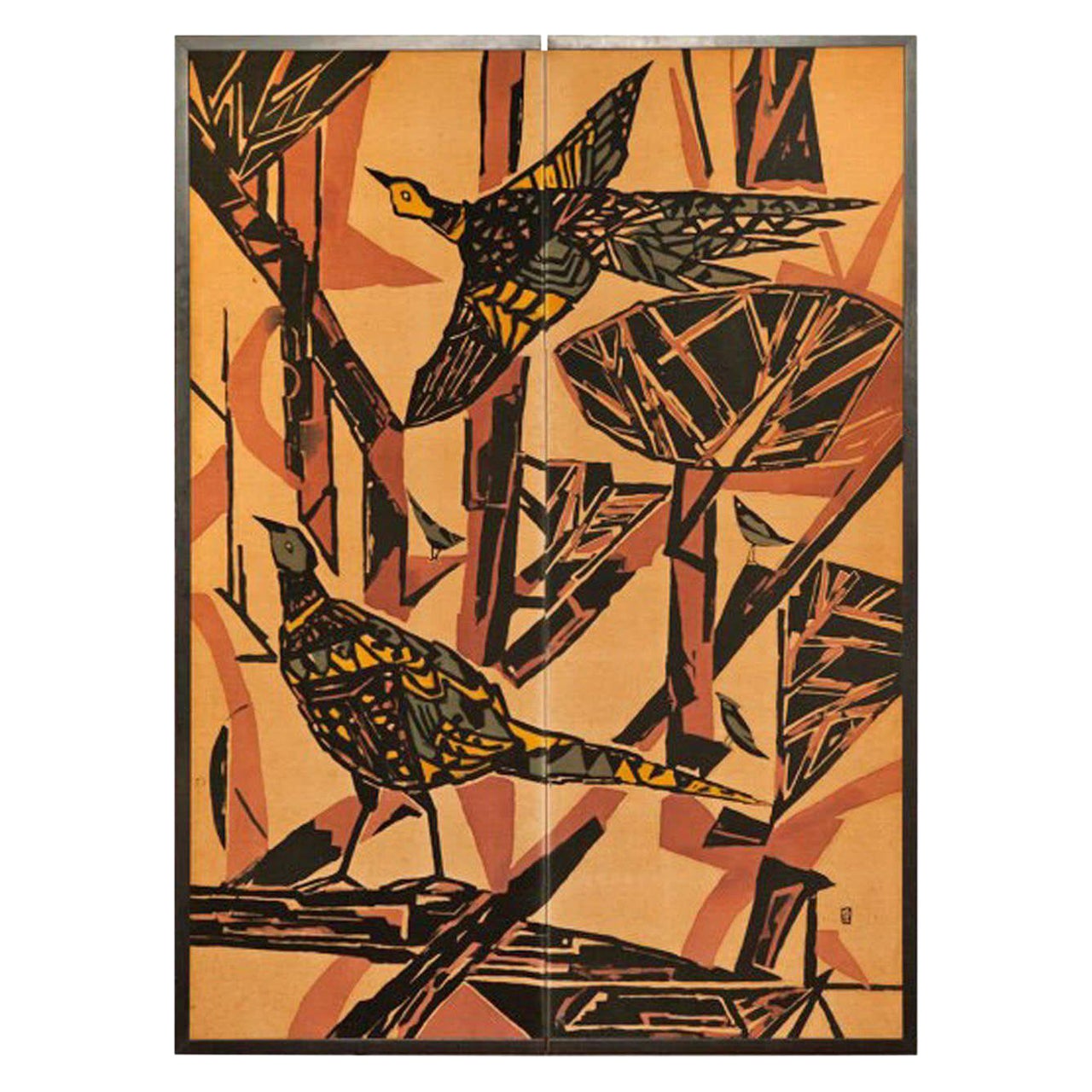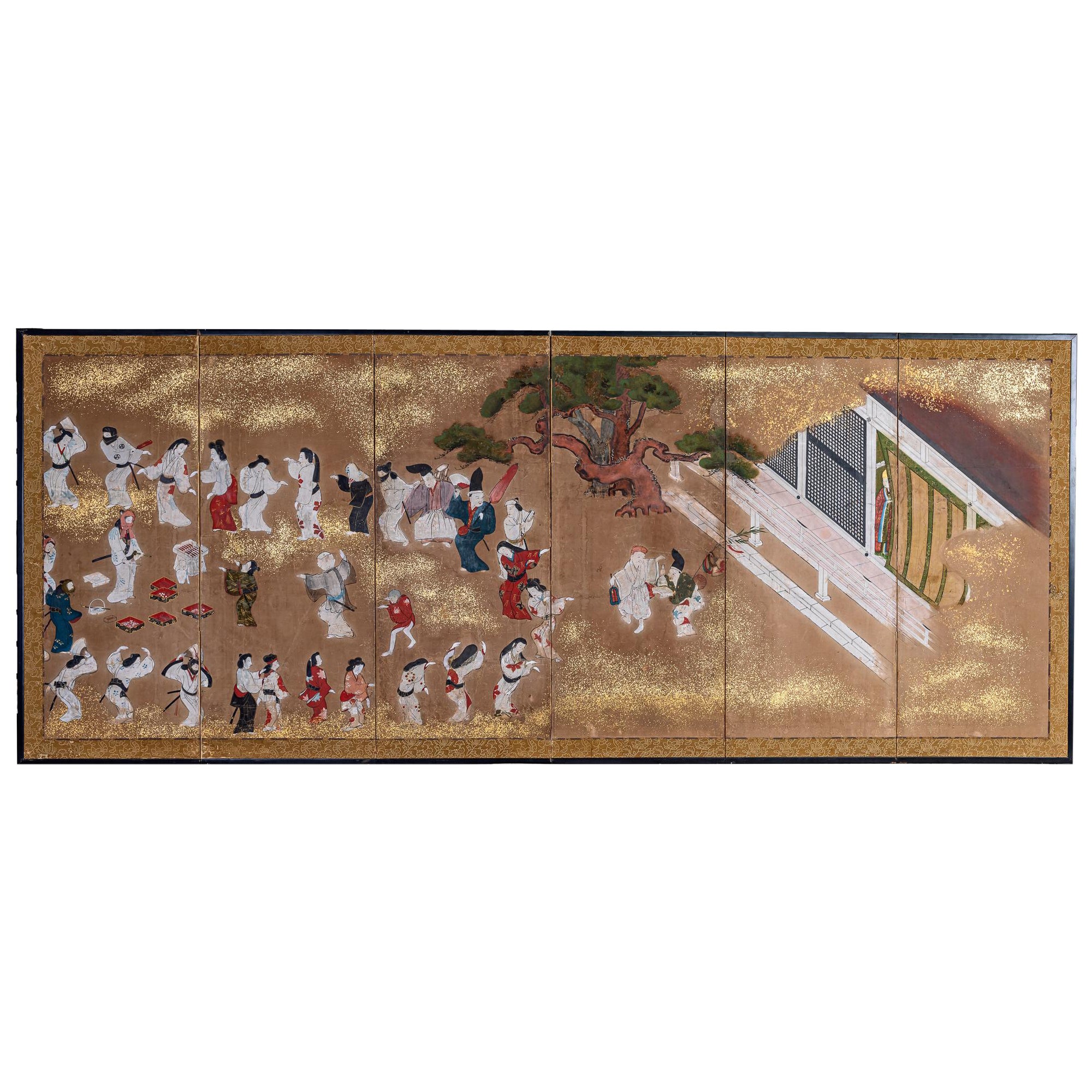Items Similar to Japanese screen with a painting of an large elephant & monkey by Mori Kanson 森間村
Want more images or videos?
Request additional images or videos from the seller
1 of 20
Japanese screen with a painting of an large elephant & monkey by Mori Kanson 森間村
About the Item
A marvellous, tall six-panel byôbu (folding screen) with a rare painting of a large white elephant standing under a blooming paulownia tree (kiri), with a monkey sitting on the ear of his host, looking straight to the spectator.
The friendly looking elephant has an almost human expression. In Japan white elephants symbolize the mind that has been trained to be strong and calm. Because elephants are not native animals in Japan, images were inspired by illustrations and therefore depicted with a lot of fantasy, often not very realistic. Painted on purpose in a "non fitting" manner - partly going beyond the frame to underline the size of this impressive and important animal.
The paulownia is considered as the tree of life. The combination of the elephant and a monkey might be a one of a kind image.
Signed: 'Mori Kanson' with two name seals.
Dimensions:
Total width: 142.83 in/362.8 cm ( 2 x 24.37 in/61.9 cm and 4 x 23.50 in/59.7 cm), Height: 67.79 in/172.2 cm.
Weight 38.36 lb/17.4 kg.
Period: Japan - Late Edo period (First half 19th century).
This room divider is very suitable to be mounted flat on a wall and be presented as one piece of art.
When shipped we will add a certificate of authenticity.
Price including insured shipping.
- Dimensions:Height: 67.8 in (172.2 cm)Width: 142.84 in (362.8 cm)Depth: 0.71 in (1.8 cm)
- Materials and Techniques:
- Place of Origin:
- Period:
- Date of Manufacture:Late Edo period (First half 19th century)
- Condition:Repaired: It is in a very good condition. This screen has been completely restored in Japan and executed in a very professional and high quality manner. The frame and backside are replaced. Wear consistent with age and use. The painting itself is completely original with some minor repairs and signs of age. Please look at the photos for a clear condition reference.
- Seller Location:Amsterdam, NL
- Reference Number:
About the Seller
5.0
Vetted Seller
These experienced sellers undergo a comprehensive evaluation by our team of in-house experts.
Established in 1996
1stDibs seller since 2022
16 sales on 1stDibs
Typical response time: 9 hours
- ShippingRetrieving quote...Ships From: Amsterdam, Netherlands
- Return PolicyA return for this item may be initiated within 14 days of delivery.
More From This SellerView All
- Large Japanese 2-Panel Byôbu 屏風 'Room Divider' with Painting of Bamboo & a PoemLocated in Amsterdam, NLBeautiful, large two-panel byôbu (room divider) with a serene painting of red-leaved bamboo and rocks on an oxidized silver leaf background. Silver leaf continuously undergoes the process of oxidation, which creates a beautiful aged patina. On the left an inscription from a ‘Zekku’ poem by the Chinese poet Yang Zai (1271?1323), titled: Shan shang zhu (bamboo (painted) on a fan). Translated as : Why would people plant a lot of bamboos? The shade of a single culm is also beautiful. In the autumn night it rocks on the wind, And the fresh sound echoes in my dream. Dated: Shôwa, the year kôshin (1938). Signature unknown...Category
Early 20th Century Japanese Paintings and Screens
MaterialsOther, Silver Leaf
- Japanese 2-Panel Furosaki’byôbu 風炉先屏風 'Tea-Ceremony Folding Screen' with DragonsLocated in Amsterdam, NLA striking low and wide two-panel furosaki’byôbu (tea-ceremony room divider) painted with two bright white dragons (ryû) flying amidst swirling black clouds. The left dragon holds a ...Category
Early 20th Century Japanese Paintings and Screens
MaterialsWood, Paper
- 260 Year Old Japanese Hanging Scroll with Painting of the 9-Headed Dragon DeityLocated in Amsterdam, NLAmazing 260 year old Japanese kakejiku (hanging scroll) with a refined painting of the nine headed dragon deity, with a Buddhist flame as a crown, an...Category
Antique Mid-18th Century Japanese Paintings and Screens
MaterialsMetal
- Large Japanese 6-panel byôbu 屏風 (folding screen) with genre paintingLocated in Amsterdam, NLFascinating large six-panel byôbu (folding screen) with a detailed genre painting on goldish silver leaf with different scenes of people at work in a rural mountain village during th...Category
Early 20th Century Japanese Paintings and Screens
MaterialsSilver Leaf
- Beautiful Japanese large 6-panel byôbu 屏風 with cranes 鶴 and pine tree 松, signedLocated in Amsterdam, NLA very beautiful large six-panel byôbu (room-divider) with a refined polychrome painting on paper of a pine tree (matsu) and two cranes (tsuru). In Japanese culture, the pine tree i...Category
Antique Early 1900s Japanese Paintings and Screens
MaterialsLacquer, Paint, Paper
- Large Japanese 6-panel byôbu 屏風 (folding screen) with Edo genre paintingLocated in Amsterdam, NLRemarkable and large six-panel byôbu (folding screen) with a detailed genre painting on gold leaf of different scenes of the town Yoshida, one of the Tôkaidô road stations. It shows ...Category
Antique Early 19th Century Japanese Paintings and Screens
MaterialsMetal, Gold Leaf
You May Also Like
- Early 19th Century Japanese Screen. Cherry Blossom & Pheasants by Mori TetsuzanLocated in Kyoto, JPMori Tetsuzan (1775-1841) Pheasants and Cherry Blossoms Two-fold Japanese screen. Ink, color, gofun, gold and silver on paper. A two-fold Japanese bir...Category
Antique Early 19th Century Japanese Edo Paintings and Screens
MaterialsGold Leaf
- Japanese Silk Scroll Painting of Moneys Edo Period Mori TetsuzanLocated in Atlanta, GAA Japanese mounted vertical hanging scroll painting by Mori Tetsuzan (Japanese, 1775-1841) circa 19th century Edo period. The watercolor and ink on silk ...Category
Antique 19th Century Japanese Japonisme Paintings and Screens
MaterialsSilk, Paper
- Japanese Screen Painting, Circa 1700 'Tales of Ise' by Tosa MitsusukeBy Tosa Mitsusuke 1Located in Kyoto, JPA six-fold Japanese screen by Tosa Mitsusuke (1675-1710), Japan 17th-18th century, Edo period. The signature reads Shoroku-i ge Tosa sa Konoe Shogen Mit...Category
Antique Late 17th Century Japanese Edo Paintings and Screens
MaterialsGold Leaf
- Japanese Two Panel Screen: Pheasants in an Abstract LandscapeLocated in Hudson, NYJapanese Two Panel Screen: Pheasants in an Abstract Landscape. Taisho period (1912-1926) bold, almost graphic painting of pheasants and other bir...Category
Early 20th Century Japanese Taisho Paintings and Screens
MaterialsFabric, Wood
- Japanese Screen Painting, circa 1700 'Horses' by Kano TanshinLocated in Kyoto, JPHorses Kano Tanshin Morimasa (1653-1718) Two-panel tea-ceremony Japanese screen or furosaki Ink on gold leaf, late 17th-early 18th century Measures: H 55 cm x W 182 cm The Kano school was closely aligned with the warrior class in Japan. The samurai, who lived in a closed and rigid hierarchical society established by the Shogunate, were drawn to the energy and freedom horses symbolize; Kano school artists commonly depicted the equine creatures as they are here, in unfettered and carefree family groups. China originally introduced horse paintings to Japan; the works typically focused on capturing the essence of horses in their various environments and often involved integrating human figures into the images. Kano Tanshin Morimasa (1653-1718) was the son of Kano Tanyu...Category
Antique 1690s Japanese Edo Paintings and Screens
MaterialsGold Leaf
- Japanese Six Panel Screen: Tosa School Painting of Theatre SceneLocated in Hudson, NYwith thought to be Izumo no Okuni (1578-1613). Mineral pigments and gold dust on mulberry paper with silk brocade border.Category
Antique 18th Century Japanese Paintings and Screens
MaterialsGold
Recently Viewed
View AllMore Ways To Browse
Antique Bes
Antique Be
Brown And White Antique Paintings
Large Elephant
Metal Paper Weight
White Room Screen
Antique Japanese Screens
Japan Antique Screens
Screen With Trees
Silk Screen Paintings
Japanese Wood Painting
Japanese Late Edo Period
Large Screen Panel
Painting Of Woods And Trees
Standing Screen
Screens And Wall Panels
Antique Silk Screen Painting
Large Asian Screen





